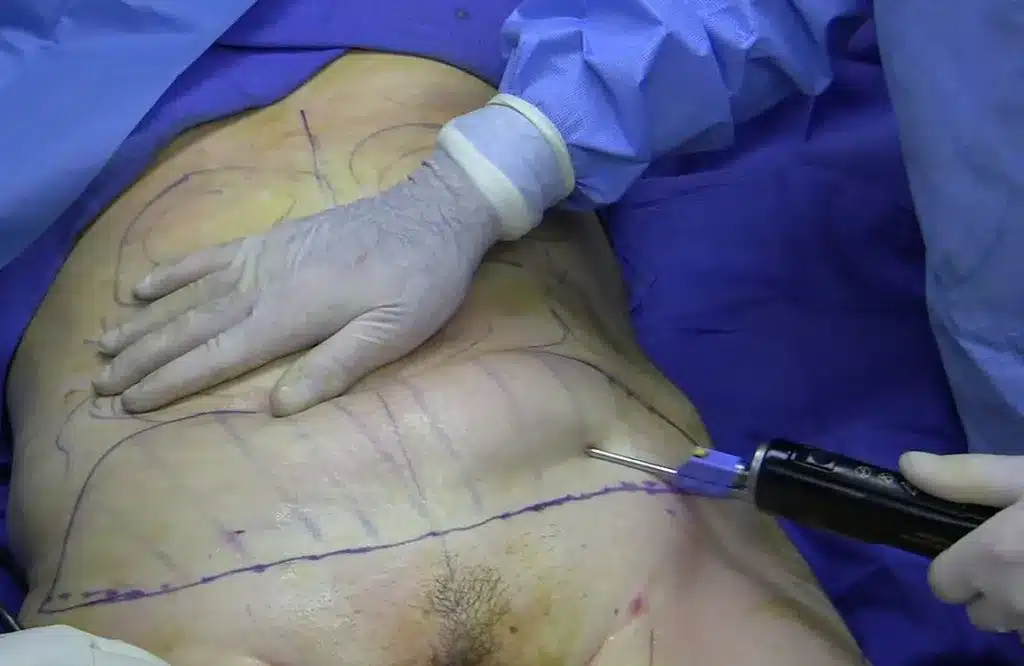Liposuction, along with tummy tuck and lipectomy, is a popular cosmetic procedure that has transformed many lives by providing improved body contour and addressing cellulite since its introduction in the 1970s. While it offers significant benefits, such as body contouring and fat removal in cosmetic surgery procedures, it’s crucial to understand the liposuction side effects related to this surgical procedure and any medicines involved. Patients often face liposuction risks and complications like swelling, bruising, numbness liposuction procedures, and changes in skin texture in their overview liposuction results. Some men may experience more serious liposuction risks, including infection or blood clots from the liposuction procedure and medicine. Awareness of these potential risks in the liposuction procedure can help individuals make informed decisions about their bodies and medicine. This post will dive deep into the common and rare side effects of liposuction, empowering you with knowledge to navigate this journey safely.
Key Takeaways
- Liposuction carries risks, including common side effects like swelling and bruising, which you should prepare for before the procedure.
- Rare complications can occur, such as infections or blood clots; suction is essential to discuss these with your doctor to understand your specific risks.
- The recovery process is crucial; follow your surgeon’s guidelines to manage pain, minimize side effects effectively, and understand liposuction risks.
- Stay informed about managing side effects and liposuction risks during recovery by implementing recommended practices like wearing compression garments and staying hydrated.
- Before undergoing liposuction, have an honest discussion with your doctor about your health history to assess your candidacy and ensure a safe procedure.
- Proper preparation can lead to better outcomes; make sure to follow pre-procedure considerations, such as avoiding certain medications, understanding liposuction risks, and arranging post-surgery support.
Overview of Liposuction Risks
Contour Irregularities
Liposuction can lead to contour irregularities. This happens when fat is removed unevenly. Patients may notice bumps or dents in the skin. These irregularities can be more noticeable in thinner individuals. They may require additional procedures to correct.
Surgeons use various techniques to minimize this risk. Proper planning and technique are crucial. They assess the patient’s body shape before surgery. The goal is to create a smooth, even appearance post-surgery while considering liposuction risks.
Fluid Buildup
Another risk involves fluid buildup, known as seromas. Seromas occur when fluid collects under the skin after surgery, often due to suction. This can cause swelling and discomfort. It typically develops within a few weeks after the suction procedure.
Management of seromas usually involves draining the fluid. A healthcare provider may use a syringe for suction in this process. In some cases, patients might need suction compression garments to reduce swelling. Following post-operative care instructions helps prevent this issue.
Numbness and Infection
Patients may experience numbness after liposuction. This happens due to nerve irritation during the procedure. Numbness can be temporary or, in rare cases, permanent. Most patients report improvement over time.
Infection is another serious risk associated with liposuction. It can occur at the incision sites or deeper tissues due to suction. Signs of infection include redness, swelling, and pus discharge. Prompt medical attention is necessary if these symptoms appear.
Internal Puncture Risks
Internal punctures are also a concern during liposuction. Surgeons use suction cannulas to remove fat, which can accidentally damage internal organs or blood vessels. This risk increases in areas with dense fat deposits.
Injuries from internal punctures can lead to severe complications. These may include suction, bleeding or organ damage, which requires immediate intervention. It’s essential for surgeons to have proper training and experience, including suction techniques, to minimize these risks.
Common Side Effects
Temporary Swelling
Swelling occurs in almost all patients after liposuction. This common type of side effect can last for several weeks. The body retains fluid, leading to noticeable swelling in the treated areas after suction.
Bruising often accompanies this swelling. Patients may notice blue shading on their skin. This happens due to suction and blood vessels breaking during the procedure. Bruises typically fade over time due to suction but can take a few weeks to disappear completely.
Mild Pain
Mild pain is another frequent experience after surgery. Many patients report discomfort in the areas where liposuction took place. This discomfort usually arises from the body’s healing process.
Pain levels vary among individuals. Some may feel soreness, while others describe it as a dull ache. Doctors often recommend over-the-counter pain relief to manage these sensations.
Numbness and Skin Changes
Temporary numbness can occur in the treated regions. Patients might feel changes in skin sensation, such as suction, tingling, or heightened sensitivity. These changes are usually short-lived and resolve within a few weeks.
Differences in sensation might cause concern for some individuals. It’s important to remember that these effects are part of the recovery process. Over time, normal sensation generally returns.
Recovery Considerations
Patients should follow post-operative care instructions closely. Staying hydrated helps minimize swelling. Drinking plenty of fluids, especially salt water, can aid recovery.
Light exercise, like walking, is encouraged after a few days. Gentle movement promotes circulation and can help reduce discomfort.
Emotional Impact
The emotional aspect of recovery is significant too. Some may feel anxious about how their body looks during healing. Changes in appearance can affect self-esteem temporarily.
Support from friends and family can be beneficial during this time. Sharing experiences with others who have undergone liposuction may also offer comfort.
Rare Complications
Fat Embolism
Fat embolism is a serious risk associated with liposuction. This occurs when fat globules enter the bloodstream. They can travel to vital organs, causing severe complications. Symptoms may include difficulty breathing and confusion. In some cases, fat embolism can be fatal. The likelihood of this complication increases with larger volumes of fat removed. Medical professionals must monitor patients closely to catch any signs early.
Kidney and Heart Issues
Large volume liposuction can lead to kidney and heart problems. Removing excessive fat can strain the body’s systems. It may cause fluid imbalances that affect kidney function. Patients might experience changes in urine output or swelling. Heart issues can also arise due to increased stress on the cardiovascular system. These risks highlight the importance of careful planning before surgery. Doctors should evaluate each patient’s health thoroughly.
Lidocaine Toxicity
Lidocaine is often used for anesthesia during liposuction. However, lidocaine toxicity is a rare but serious complication. It can happen if too much lidocaine enters the bloodstream. Symptoms include dizziness, confusion, and seizures. In severe cases, it can lead to cardiac arrest. Medical teams must calculate the correct dosage based on the patient’s weight and procedure type. Monitoring during surgery helps prevent this issue.
Bruising and Infection
Bruising and infection are common side effects discussed earlier. However, they can escalate into rare complications if not managed properly. Severe bruising may indicate deeper tissue damage or hematoma formation. Infections can spread quickly without prompt treatment. Signs of infection include fever and increased pain at the site. Patients must follow post-operative care instructions strictly to minimize these risks.
Summary of Risks
Patients considering liposuction should understand these rare complications:
- Fat embolism: Serious risk affecting vital organs.
- Kidney and heart issues: Potential problems from large volumes of fat removal.
- Lidocaine toxicity: Rare but dangerous reaction to anesthesia.
Awareness of these factors is crucial for informed decision-making.
Understanding Recovery Process
Duration
Recovery from liposuction typically takes several weeks. Most patients can return to light activities within a week. However, full recovery may take up to six months. During this time, the body heals and adjusts to the changes made during surgery. Swelling and bruising often appear initially but gradually decrease over time.
Post-operative Care
Following post-operative care instructions is crucial for a successful recovery. Surgeons provide guidelines that include wearing compression garments. These garments help reduce swelling and support the skin as it adjusts. Patients should also avoid strenuous activities during the initial recovery phase. Ignoring these instructions can lead to complications or prolonged healing times.
Gradual Improvement
Patients experience gradual improvement in their appearance and comfort over weeks to months. Initially, swelling may obscure results, making it hard to see the final outcome. As healing progresses, body contours become more defined. Comfort levels also increase as pain diminishes and mobility improves.
In the first few days after surgery, discomfort is common. Pain medications help manage this discomfort effectively. By two weeks, many patients find they can resume most daily activities with ease.

Managing Side Effects During Recovery
Swelling Reduction
Compression garments are essential after liposuction. They help reduce swelling and bruising. Wearing these garments can improve blood circulation. This leads to faster healing. Most doctors recommend wearing them for several weeks post-surgery.
Elevating the treated areas can also help. Keeping limbs raised reduces fluid buildup. Ice packs can provide relief as well. Applying ice for 20 minutes at a time can ease discomfort.
Pain Management
Pain is common after liposuction. Doctors often prescribe pain medicines to manage discomfort. It’s important to take these medications as directed. Over-the-counter pain relievers may also be helpful.
Avoiding strenuous activities is crucial during recovery. Rest allows the body to heal properly. If pain persists or worsens, contact your doctor immediately.
Infection Monitoring
Monitoring for signs of infection is vital during recovery. Look for symptoms such as increased redness, swelling, or discharge from incisions. Fever may also indicate an infection.
If any of these symptoms occur, reach out to your healthcare provider right away. Early intervention can prevent complications.
Time for Recovery
Recovery time varies for each individual. Generally, most people resume normal activities within a few weeks. However, full recovery may take several months. Patience is key during this period.
Following your doctor’s instructions helps ensure a smooth recovery process. Regular follow-ups with your doctor are important for monitoring progress. They will assess how well you are healing and adjust treatment if necessary.
Emotional Support
Recovering from liposuction can be emotionally challenging. Some individuals experience mood swings due to changes in body image and hormonal shifts. Seeking support from friends or family can provide comfort.
Consider joining support groups where experiences are shared openly. Connecting with others who have undergone similar procedures can be reassuring.
Pre-Procedure Considerations
Medical History
Surgeons need to know a patient’s medical history before any liposuction procedure. This information helps them assess risks and tailor the surgical technique accordingly. Previous surgeries, allergies, and chronic conditions can affect recovery.
People must be honest about their health issues. For instance, conditions like diabetes or heart disease may complicate the surgical area. A thorough discussion can lead to better outcomes.
Medication Management
Certain medications can increase risks during surgery. Patients should stop taking blood thinners before the procedure. Common drugs include aspirin and ibuprofen. These medications can lead to excessive bleeding during the surgical technique.
Surgeons often provide a list of medications to avoid. Following these guidelines helps ensure safety. It is crucial for patients to adhere strictly to these recommendations.
Lab Tests
Surgeons may recommend specific lab tests before liposuction. These tests help evaluate overall health and readiness for the procedure. Blood tests can check for anemia or infections that could complicate recovery.
Patients often undergo physical exams as well. These assessments allow surgeons to understand each individual’s unique conditions. They tailor the surgical area approach based on test results.
Clinic Selection
Choosing the right clinic is vital for a successful experience. Patients should research clinics thoroughly. Look for certified facilities with experienced surgeons specializing in liposuction procedures.
Reading reviews from previous patients can provide insights into the clinic’s reputation. A reputable clinic will prioritize patient safety and satisfaction throughout the process.
Amount of Fat Removal
Surgeons typically limit the amount of fat removed in one session. The standard recommendation is no more than five liters at a time. Removing too much fat can lead to serious complications.
Discussing expectations with the surgeon is important. Understanding how much fat removal is safe helps set realistic goals for body contouring.
Psychological Readiness
Psychological readiness plays an essential role in successful outcomes. People considering liposuction should have realistic expectations about results. This procedure isn’t a weight-loss solution but rather a body contouring technique.
Surgeons often recommend counseling sessions before surgery if needed. Addressing emotional concerns can improve recovery and satisfaction with results.
Preparing for Liposuction
Marking Areas
Surgeons mark the treatment areas before the liposuction procedure. This step is crucial for ensuring accuracy during the surgery. The markings help define where fat removal will occur. They also guide the surgeon in achieving balanced results. Patients should expect to discuss their goals with the surgeon beforehand. This conversation helps set realistic expectations.
The marked areas are typically done while the patient is standing. This position allows the surgeon to see how gravity affects body contours. It ensures that the liposuction surgery targets specific problem areas effectively.
Pre-Operative Photos
Taking pre-operative photos is a common practice. These images serve as a reference point after the surgery. Surgeons often compare these photos to post-operative results. This comparison can show patients their progress and outcomes.
Photos can also help in understanding the changes made during the fat removal surgery. Many patients find it motivating to see their transformation over time. It’s important for patients to feel comfortable with this process and understand its purpose.
Surgical Environment
The setting of the surgery may vary based on the extent of fat removal planned. For minor procedures, outpatient facilities are often sufficient. However, if extensive fat removal is necessary, a hospital may be required.
In such cases, patients might stay overnight for monitoring. This ensures safety during recovery from anesthesia and potential complications. Surgeons assess whether a hospital setting is needed based on individual circumstances.
Specific Techniques
Different liposuction techniques can influence preparation steps. Tumescent liposuction, for example, uses a special fluid to minimize bleeding and pain. Understanding which technique will be used helps patients prepare mentally and physically.
Patients should also discuss any medications they take prior to surgery. Some medications can increase bleeding risks or affect anesthesia. Following pre-operative instructions is essential for a successful outcome.
Emotional Readiness
Emotional readiness is another key aspect of preparing for liposuction. Patients should reflect on their motivations for undergoing this weight loss procedure. Understanding personal goals can lead to better satisfaction with results.
Support from family and friends can ease anxiety about surgery. Discussing concerns with a liposuction surgeon can also provide reassurance.
Assessing Candidacy for Liposuction
Ideal Candidates
Candidates for liposuction should meet specific health criteria. They must be in good overall health, free from serious medical conditions. Conditions like heart disease or diabetes can complicate the surgery. A cosmetic surgeon evaluates each patient’s medical history to ensure safety.
Realistic expectations are crucial. Patients should understand that liposuction is not a weight loss solution. Instead, it is a cosmetic surgery option to shape and contour specific body areas. Those seeking the procedure should aim for a stable weight before undergoing surgery. This stability helps achieve better results and reduces complications.
Skin Elasticity
Good skin elasticity plays an essential role in the success of liposuction. Patients with firm skin will likely have smoother results post-surgery. Skin that lacks elasticity may sag after fat removal. This sagging can lead to disappointment with the outcome.
A cosmetic surgeon often assesses skin quality during consultations. They may recommend other procedures if skin elasticity is poor. These options might include skin tightening treatments or different types of aesthetic surgeries.
Weight Considerations
Stable body weight is vital before considering liposuction. Surgeons typically recommend being at or near your ideal weight. Being overweight can increase risks during surgery and recovery. It can also affect the final results.
Patients should ideally maintain their weight for at least six months before the procedure. This period allows the body to stabilize and prepares it for surgery. Surgeons prefer candidates who are committed to maintaining their weight after the procedure as well.
Fat Areas
Liposuction targets specific fat areas in the body. Common areas include the abdomen, thighs, and arms. Each area requires careful planning by the cosmetic surgeon. They will assess how much fat can be safely removed without compromising health.
Surgeons use various techniques to remove fat from these regions effectively. The choice of technique depends on the patient’s body type and goals.
Conclusiones
Liposuction can be a game-changer for your body goals, but it’s crucial to understand the side effects and risks involved. From common issues like swelling to rare complications, being informed helps you prepare better. Recovery is a journey that requires patience and care. You need to manage side effects effectively and follow pre-procedure guidelines to ensure a smoother experience.
Knowledge is power. Assessing your candidacy is vital to achieving the best results. If you’re considering liposuction, don’t hesitate to consult with a qualified professional. They can help you navigate the process and set realistic expectations. Your well-being matters, so take the next step with confidence and clarity.
Frequently Asked Questions
What are the common side effects of liposuction?
Common side effects include swelling, bruising, pain, and temporary numbness. Most symptoms resolve within a few weeks as the body heals.
Are there any rare complications associated with liposuction?
Yes, rare complications can include blood clots, infection, skin necrosis, and uneven contours. These risks highlight the importance of choosing a qualified surgeon.
How long is the recovery process after liposuction?
Recovery typically takes about 1 to 2 weeks for initial healing. Full recovery may take several months as swelling subsides and results stabilize.
What can I do to manage side effects during recovery?
To manage side effects, follow your surgeon’s post-operative care instructions. Staying hydrated, wearing compression garments, and resting can aid recovery.
How should I prepare for a liposuction procedure?
Preparation includes consulting with your surgeon, discussing medical history, avoiding certain medications, and arranging for post-operative care.
Who is a good candidate for liposuction?
Good candidates are generally healthy individuals at or near their ideal weight with localized fat deposits. A consultation will help determine suitability.
Is liposuction safe?
Liposuction is considered safe when performed by a qualified surgeon in an accredited facility. Understanding risks and following pre-operative guidelines enhances safety.





